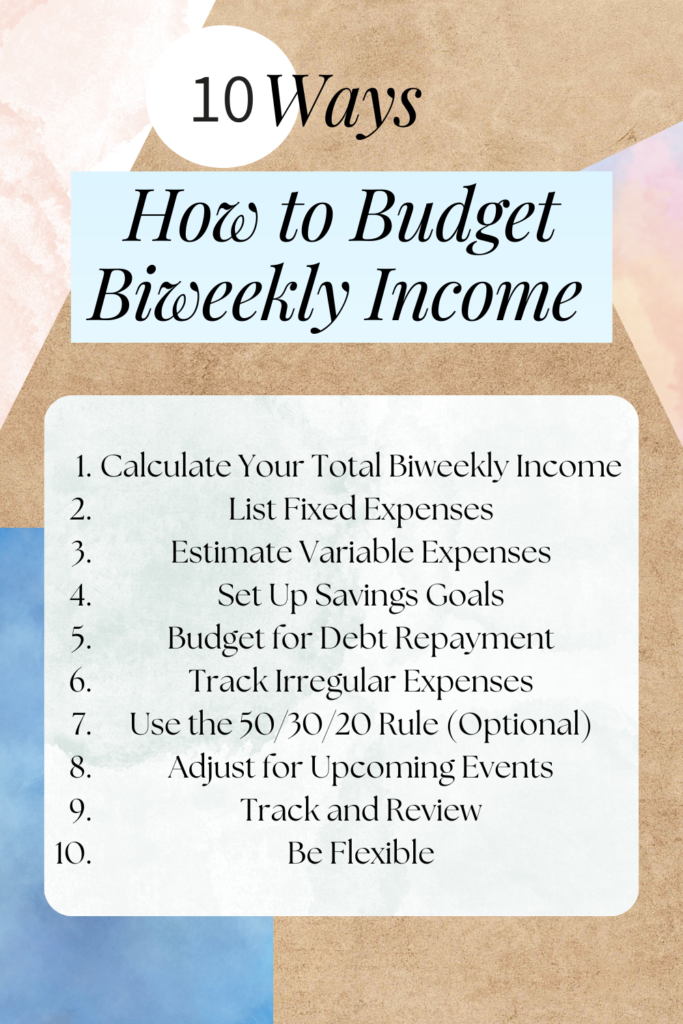Budgeting biweekly income requires organizing your finances to ensure that you’re managing your money efficiently over a two-week period. Below is a step-by-step guide to help you create a budget for a biweekly income:
1. Calculate Your Total Biweekly Income
- Identify your regular income: Start with your regular biweekly paycheck. If you’re salaried, this will be consistent. If you’re hourly, multiply your hourly rate by the number of hours worked in two weeks.
- Include other income sources: Consider any additional income sources, such as bonuses, freelance work, or side gigs, and add them to your total.
2. List Fixed Expenses
Fixed expenses are costs that don’t change from month to month and usually have a set due date:
- Rent or mortgage
- Utilities (electricity, water, internet)
- Car payment
- Insurance (health, car, home)
- Loan payments
- Subscriptions (streaming services, gym membership, etc.)
3. Estimate Variable Expenses
These are expenses that vary from week to week or month to month, such as:
- Groceries
- Gas
- Dining out or takeout
- Entertainment
- Personal care (e.g., toiletries, haircuts)
- Household supplies
4. Set Up Savings Goals
It’s important to allocate money for savings, even if it’s a small amount. You can split savings into different categories:
- Emergency fund
- Retirement (e.g., 401(k) or IRA contributions)
- Short-term savings (vacation, new gadgets, etc.)
5. Budget for Debt Repayment
If you have outstanding debt (credit cards, student loans, etc.), allocate part of your income to pay it off. Prioritize high-interest debt to save money in the long run.
6. Track Irregular Expenses
Some expenses may not happen every month, like insurance premiums or annual memberships. Break these down into monthly or biweekly amounts so you can plan for them. For example, if you pay insurance annually, divide the yearly cost by 26 (for 26 biweekly periods) to determine how much to save every two weeks.
7. Use the 50/30/20 Rule (Optional)
One common approach to budgeting is the 50/30/20 rule:
- 50% for needs (fixed expenses like rent, utilities, groceries)
- 30% for wants (discretionary spending like entertainment, dining out)
- 20% for savings and debt repayment (emergency fund, retirement savings, credit card payments)
8. Adjust for Upcoming Events
Be sure to account for any one-time or seasonal expenses, such as holidays, birthdays, or vacations. Plan for these in advance so they don’t disrupt your regular budgeting.
9. Track and Review
Use a budgeting tool (like a spreadsheet, app, or pen-and-paper) to track your spending over the two weeks. At the end of each period, review your budget to see if you’ve stayed within limits and identify areas where you can improve.
Example Budget Breakdown (for Biweekly Income of $2,000)
| Category | Amount |
|---|---|
| Income | $2,000 |
| Fixed Expenses | |
| Rent/Mortgage | $800 |
| Utilities | $150 |
| Insurance | $100 |
| Loan Payment | $200 |
| Variable Expenses | |
| Groceries | $250 |
| Gas | $50 |
| Entertainment | $75 |
| Dining Out | $75 |
| Savings & Debt Repayment | |
| Emergency Fund | $100 |
| Retirement Fund | $100 |
| Credit Card Payment | $100 |
| Total | $2,000 |
10. Be Flexible
Life changes, and so will your income and expenses. Be flexible with your budget, and make adjustments when necessary. If you get a raise or a one-time bonus, consider putting some or all of it into savings or paying down debt.
By following these steps, you’ll be able to successfully budget your biweekly income and take control of your finances.


